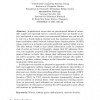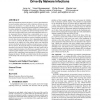4 search results - page 1 / 1 » TAO: Protecting Against Hitlist Worms Using Transparent Addr... |
CMS
2006
13 years 6 months ago
2006
Abstract. Sophisticated worms that use precomputed hitlists of vulnerable targets are especially hard to contain, since they are harder to detect, and spread at rates where even au...
CN
2007
13 years 4 months ago
2007
Worms are self-replicating malicious programs that represent a major security threat for the Internet, as they can infect and damage a large number of vulnerable hosts at timescal...
WORM
2003
13 years 6 months ago
2003
This paper presents DOME, a host-based technique for detecting several general classes of malicious code in software executables. DOME uses static analysis to identify the locatio...
CCS
2010
ACM
13 years 5 months ago
2010
ACM
Web-based surreptitious malware infections (i.e., drive-by downloads) have become the primary method used to deliver malicious software onto computers across the Internet. To addr...


